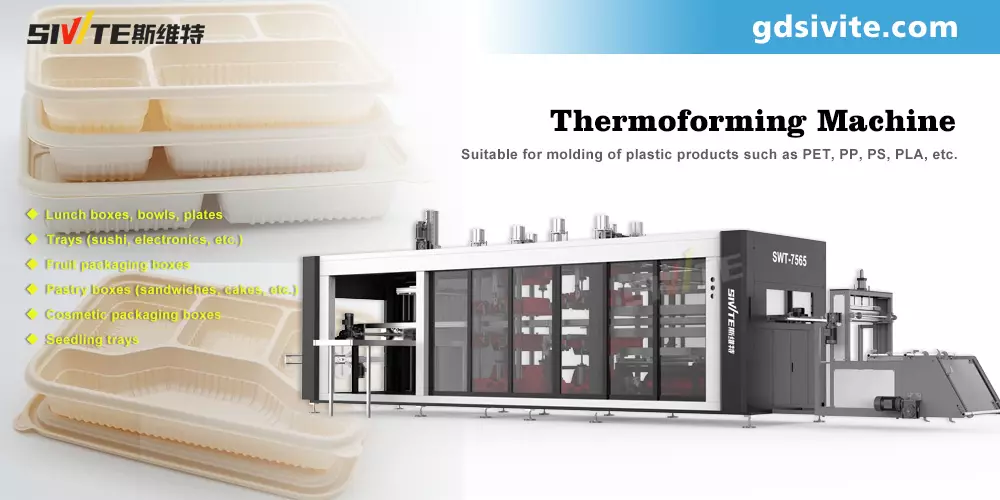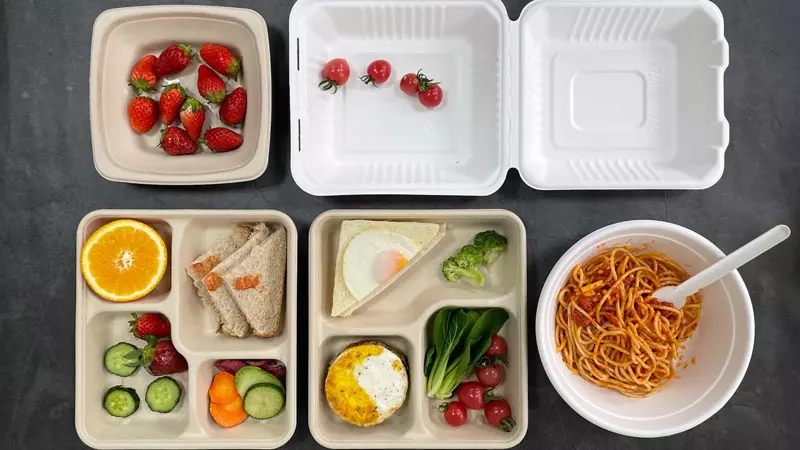How are PLA, PBAT Degradable Takeout Boxes Produced?
In today's eco-conscious market, biodegradable food containers made from PLA (Polylactic Acid) and PBAT (Polybutylene Adipate Terephthalate) have become increasingly popular alternatives to traditional plastic packaging. This article explores the manufacturing process of these sustainable containers, focusing on the crucial role of thermoforming machines in production.
Understanding Biodegradable Materials
Before diving into production, let's examine the materials used:
-
PLA (Polylactic Acid): Derived from renewable resources like corn starch or sugarcane, PLA is a fully biodegradable polymer that breaks down under industrial composting conditions.
-
PBAT: A petroleum-based but biodegradable polymer often blended with PLA to improve flexibility and heat resistance.
-
Starch-based composites: Materials incorporating corn starch or bamboo powder that enhance biodegradability while reducing material costs.

These materials fall into two categories:
- Fully biodegradable: Completely breaks down into water, CO₂, and biomass (typically PLA-based)
- Semi-biodegradable: Partially degrades, leaving some microplastic residues (often PBAT blends)
The Manufacturing Process
1. Material Preparation
The production begins with preparing the raw materials. PLA pellets are often blended with PBAT (typically 70% PLA to 30% PBAT ratio) and other additives like bamboo powder or corn starch to create a compound with optimal properties for food containers.
2. Sheet Extrusion
The compound is fed into an extruder where it's melted and formed into thin sheets of uniform thickness (usually 0.2mm-0.5mm). Temperature control is critical here, typically maintained between 160-180°C for PLA/PBAT blends.
3. Thermal Forming with Thermal Forming Machines
This is where thermoforming machines play their pivotal role. The sheets are heated to a pliable state (about 60-80°C) and then vacuum-formed or pressure-formed into the desired container shapes. Modern thermoforming machines can achieve remarkable speeds of 2-3 seconds per mold cycle.
Key advantages of using thermoforming machines:
- High production efficiency
- Consistent product quality
- Energy efficiency compared to injection molding
- Flexibility to produce various container designs
4. Trimming and Quality Control
After forming, excess material is trimmed, and containers undergo rigorous quality checks for thickness consistency, structural integrity, and food safety compliance.
Production Capacity Analysis
With thermoforming machines operating at 2-3 seconds per cycle, let's calculate potential annual output:
- Assuming: 2.5 seconds average cycle time
- 24/7 operation with 85% efficiency (accounting for maintenance and changeovers)
- Single mold cavity (most machines have multiple cavities)
Calculations:
- Cycles per hour: 3,600 seconds ÷ 2.5 = 1,440 cycles
- Daily output: 1,440 × 24 × 0.85 ≈ 29,400 units
- Annual output: 29,400 × 365 ≈ 10.7 million units
For a typical thermoforming machine with 6 cavities:
- Annual output reaches approximately 64 million units
Larger facilities with multiple machines can easily produce hundreds of millions of biodegradable containers annually.
Environmental Benefits
The shift to PLA/PBAT containers offers significant sustainability advantages:
- Reduced carbon footprint: PLA production emits 60-70% less CO₂ than conventional plastics
- Renewable sourcing: Corn starch and bamboo are annually renewable resources
- Waste reduction: Containers degrade in 3-6 months under industrial composting vs. 500+ years for conventional plastics
Market Considerations
As global regulations tighten on single-use plastics, demand for biodegradable alternatives is surging. The global biodegradable food packaging market is projected to grow at 12.4% CAGR from 2023 to 2030, reaching $27.3 billion.
Conclusion
The production of PLA and PBAT biodegradable food containers represents a perfect marriage of sustainability and manufacturing efficiency. By utilizing advanced SIVITE thermoforming machines, manufacturers can achieve high-volume production while meeting environmental objectives. With production speeds of 2-3 seconds per mold and annual capacities reaching tens of millions of units, this green technology is well-positioned to replace traditional plastic packaging across the food service industry.
For businesses considering entering this growing market, investing in modern thermoforming machines and understanding the nuances of biodegradable materials will be key to success in the eco-friendly packaging revolution.
Previous: No More
Next: How are sauce cups produced? The most efficient production equipment

